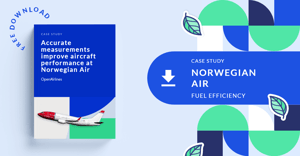How is Norwegian one of the most fuel-efficient airlines in the world?

Norwegian is one of the world’s largest low-cost airlines. In 2018, Norwegian carried 37 million passengers. The airline operates a fleet of more than 170 aircraft, with an average age of 3.8 years, making it one of the youngest and most fuel-efficient fleets in the world.
Moreover, Norwegian has been named the Most Fuel-Efficient Airline on Transatlantic Routes by the International Council on Clean Transportation (ICCT) twice.

Stig Patey, Fuel Saving Manager and Captain on the 737 at Norwegian for 13 years explains how the airline uses SkyBreathe to increase fuel savings:
What were your goals and main issues when you chose SkyBreathe®?
The main issue was that we wanted to “realize” fuel efficiency, and we couldn’t do that with a system just telling management what flight crew were doing or not: we wanted to get that information to the pilots themselves.
We wanted pilots to be able to see what they were doing well and what they were able to improve. Since the flight crew is at the sharp end of the operations, we also wanted them to be able to provide feedback through the application. For example, giving feedback saying: “We couldn't use Engine-out Taxi-In on that day because one runway was closed. So, we had to cross some active runway. Air Traffic Control required us to do that.”
Keeping flying crews in the loop was a requirement since they were the ones being there on the scene.
What made you choose SkyBreathe®?
First, flight crews operate in a very complex environment, with challenging Air Traffic Control restraints and the necessity to adapt to weather conditions. So, it is very important that the fuel efficiency system truly understands the conditions the flight crew operates in.
For example, if we have snow coming on the runway, it won’t be possible to use Idle Reverse Thrust on landing, and maybe not even Engine-Out Taxi-In procedure. Then, the system shouldn't tell the pilot afterward that he should have applied those best practices because that wouldn't make sense.
So we needed a system monitoring the weather conditions and automatically detecting that some fuel-saving best practices are not applicable in some scenarios, and then closing the loop over Standard Operating Procedures.
We also wanted our fuel efficiency system to not propose to the pilots to apply a fuel-saving best practice contrary to our safety policies.
In a nutshell, we wanted to have a system that intelligently knows the actual flight conditions and the constraints that flight crews are operating under to make sure that they get valuable feedback.
In SkyBreathe, we can identify the number of flights that could have used a fuel-saving best practice and see how well the pilots applied it. No other system can do exactly that; that’s why we chose SkyBreathe.
How did the implementation of the project go?
I think it went very well. In general, there will always be some obstacles when you implement a new system: what you don't know, that you don't know and that you will find out through the implementation.
In our case, what we didn't know was how we would implement the solution in a step-by-step way.
As you can imagine, we didn’t just turn on the system and hand out the keys to all the end users because that could create a mess. First, we’ve made sure that we had a good handful of very interested individuals who wanted to participate in testing the system. So, we ran a test with several pilots that were eager to be beta testers to check out this new feature.
We ran a few surveys about implementation and proposed some changes. Then, when these first beta users were happy, we allowed them to invite some more users. At the same time, we also notified all our pilots that we were doing this trial if they wanted to join.
That’s how we suddenly had around 400 pilots testing SkyBreathe and running that test for three or four months before we decided to implement it for all pilots.
At this time, we knew that we had around 400 motivated pilots who would then continue as ambassadors who knew the ins and outs of the system. Then, the implementation to the rest of the group went very smoothly.
Can you estimate the benefits that the solution brings to Norwegian?
In general, we have a higher application rate on fuel-saving best practices, especially Engine-Out Taxi-In and Pilot extra fuel.
Also, one of the main benefits of using SkyBreathe is that it brings up a higher understanding and awareness of fuel performance.
Flight crews now routinely discuss the application of fuel-saving best practices to a much higher level of detail than what they used to do. It also brings up some discussions that we didn't have in the past. In general, I think it raised knowledge among pilots.
What features do you particularly enjoy?
From an analyst's view, I really enjoy how easy it is to mix and match different measures to create analysis. If, during a flight operations meeting, someone has a question related to fuel saving, for example, “What is the fuel saved taxi with one engine if we have to make one stop because of traffic and then continue?” I can compare fuel burn with and without the stop easily. It's very flexible to create analyses in no time.
I also appreciate the possibility of sharing dashboards with other users.
What advice would you give to airlines that want to set up a fuel efficiency program?
First, I would say that at the end of the day, it’s the flight crew that decides the amount of fuel onboard the aircraft and decides if they would like to taxi with one engine, use Idle Reverse Thrust, or make a green approach using Continuous Descent Approach principles.
So, if you would like the flight crew to improve, you need to give them appropriate tools so that they can view their flights and see their performance just a few days after the flight. Otherwise, they will be blindfolded.
Also, there are so many different aspects to consider when improving fuel efficiency that I would first recommend looking into your operations and see where the operations can be improved. I think it is important to focus on some areas, taking a step-by-step approach, because if you tell the pilots to improve everything at the same time, it will be too much.
Moreover, as mentioned previously, when you implement your fuel-saving strategies, you also need to make sure that you have some flight crew at each operating base that can be good ambassadors to adopt the strategy.
If you had to define SkyBreathe® in one word?
I would say user-friendly. That's a good thing because as a manager, you have many things you need to do, and you don't want to do much coding to use the system. I appreciate how fast it is to learn to use SkyBreathe for anyone. Also, there is very good support, you can easily find your way through the application.
Case study: Pilot Extra Fuel

Figure 1 : Pilot Extra Fuel application
READ MORE
Like what you see? Want to learn more about fuel efficiency?
Discover case studies and stories from airlines that have been there:


.jpg)

